Blast From the Past
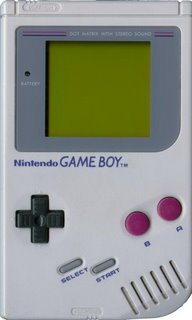
Game Boy
The original Game Boy was released on April 21, 1989 in Japan and in August 1989 in the United States with an MSRP of US$100. Based around a Z80 processor, it has a black and green reflective LCD screen, an eight-way directional pad, two action buttons, and Start and Select buttons. It plays games from ROM-based media contained in small plastic detachable units called cartridges (sometimes abbreviated as carts or GamePaks).
The original Game Boy was released on April 21, 1989 in Japan and in August 1989 in the United States with an MSRP of US$100. Based around a Z80 processor, it has a black and green reflective LCD screen, an eight-way directional pad, two action buttons, and Start and Select buttons. It plays games from ROM-based media contained in small plastic detachable units called cartridges (sometimes abbreviated as carts or GamePaks).
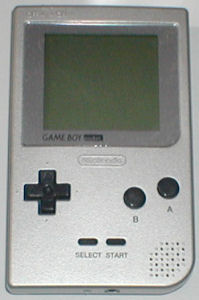
Game Boy Pocket
In 1996, Nintendo released the Game Boy Pocket, a smaller, lighter unit that required fewer batteries. It has space for 2 AAA batteries, which provides roughly 10 hours of game play. The Pocket has a smaller link port, which requires an adapter for linkage with the older Game Boy. The port design is used on all subsequent Game Boy models up until the Game Boy Micro. The screen was changed to a true black-and-white display, rather than the "pea soup" monochromatic display of the original Game Boy. The first version did not have a LED to show battery levels, but was soon added due to public demand.
In 1996, Nintendo released the Game Boy Pocket, a smaller, lighter unit that required fewer batteries. It has space for 2 AAA batteries, which provides roughly 10 hours of game play. The Pocket has a smaller link port, which requires an adapter for linkage with the older Game Boy. The port design is used on all subsequent Game Boy models up until the Game Boy Micro. The screen was changed to a true black-and-white display, rather than the "pea soup" monochromatic display of the original Game Boy. The first version did not have a LED to show battery levels, but was soon added due to public demand.
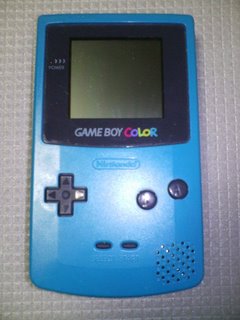
Game Boy Color
Released in November 1998, the Game Boy Color (also referred to as GBC) added a color screen to a form factor slightly larger than the Game Boy Pocket. It also has double the processor speed, twice as much memory, and an infrared communications port. Technologically, it was likened to the 8-bit NES video game console from the 1980s. A major draw of the Game Boy Color is its backward compatibility (that is, a Game Boy Color is able to read older Game Boy cartridges and even play them in selectable color). This feature works for almost every game: the most notable exception being the Galaga/Galaxian game for the original Game Boy in which some of the sound effects were missing or garbled. This backwards compatibility became a major feature of the Game Boy line, since it allowed each new launch to begin with a significantly larger library than any of its competitors.
Released in November 1998, the Game Boy Color (also referred to as GBC) added a color screen to a form factor slightly larger than the Game Boy Pocket. It also has double the processor speed, twice as much memory, and an infrared communications port. Technologically, it was likened to the 8-bit NES video game console from the 1980s. A major draw of the Game Boy Color is its backward compatibility (that is, a Game Boy Color is able to read older Game Boy cartridges and even play them in selectable color). This feature works for almost every game: the most notable exception being the Galaga/Galaxian game for the original Game Boy in which some of the sound effects were missing or garbled. This backwards compatibility became a major feature of the Game Boy line, since it allowed each new launch to begin with a significantly larger library than any of its competitors.
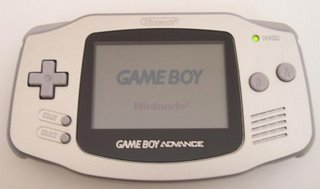
Game Boy Advance
On June 11, 2001, Nintendo released a significant upgrade to the Game Boy line. The Game Boy Advance (also referred to as GBA) featured a 32 bit 16.8 MHz ARM. It included a Z80 processor for backward-compatibility support, and sported a larger, 16:9 screen. It was technically likened to the SNES and showed its power with successful ports of Super Mario World and Yoshi's Island. It has also been accompanied alongside new titles such as Mario Kart Super Circuit and F-Zero: Maximum Velocity. It also introduced the L and R shoulder buttons to the Game Boy. It is, however, more powerful than the SNES, as can be seen from several successful 3D games that were made for it that featured much better graphics than any of the SNES games. A drawback of the Game Boy Advance is that the unit has no backlit screen, although it was a color screen, which made seeing the screen in some lighting conditions difficult.
On June 11, 2001, Nintendo released a significant upgrade to the Game Boy line. The Game Boy Advance (also referred to as GBA) featured a 32 bit 16.8 MHz ARM. It included a Z80 processor for backward-compatibility support, and sported a larger, 16:9 screen. It was technically likened to the SNES and showed its power with successful ports of Super Mario World and Yoshi's Island. It has also been accompanied alongside new titles such as Mario Kart Super Circuit and F-Zero: Maximum Velocity. It also introduced the L and R shoulder buttons to the Game Boy. It is, however, more powerful than the SNES, as can be seen from several successful 3D games that were made for it that featured much better graphics than any of the SNES games. A drawback of the Game Boy Advance is that the unit has no backlit screen, although it was a color screen, which made seeing the screen in some lighting conditions difficult.
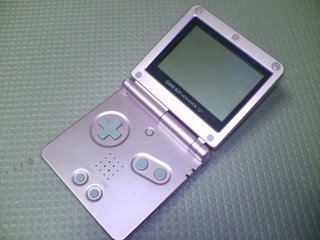
Game Boy Advance SP
Launched on March 21, 2003, the Game Boy Advance SP resolved several problems with the original model. It features a new smaller clamshell design with a flip-up screen (protecting the screen, an issue with the original), an internal light, and a rechargeable battery, but was otherwise unchanged. Owners of the original Game Boy Advance received a special limited offer to trade their old models into Nintendo and merely pay the difference on the Advance SP. Contrary to very popular belief, SP does not stand for Special Project, but simply Special. It is possible that it once officially stood for Special Project. In mid September 2005, Nintendo released a new model that featured a new and improved backlit screen. As of this writing, the Game Boy Advance SP is the last Game Boy handheld to offer backward compatibility with all Game Boy games. The Game Boy Advance SP is criticized for not being as comfortable as the original Game Boy Advance, due to its shorter width
Launched on March 21, 2003, the Game Boy Advance SP resolved several problems with the original model. It features a new smaller clamshell design with a flip-up screen (protecting the screen, an issue with the original), an internal light, and a rechargeable battery, but was otherwise unchanged. Owners of the original Game Boy Advance received a special limited offer to trade their old models into Nintendo and merely pay the difference on the Advance SP. Contrary to very popular belief, SP does not stand for Special Project, but simply Special. It is possible that it once officially stood for Special Project. In mid September 2005, Nintendo released a new model that featured a new and improved backlit screen. As of this writing, the Game Boy Advance SP is the last Game Boy handheld to offer backward compatibility with all Game Boy games. The Game Boy Advance SP is criticized for not being as comfortable as the original Game Boy Advance, due to its shorter width
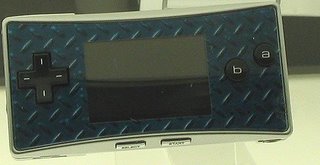
Game Boy Micro
A third Game Boy Advance design, the Game Boy Micro is four inches wide, two inches tall, and weighs 2.8 ounces. By far the smallest Game Boy created, it is approximately the same dimensions as an original NES controller pad. Its screen is slightly smaller than the SP and GBA screens while maintaining the same resolution (240 × 160 pixels). The Game Boy Micro is not backwards compatible with Game Boy or Game Boy Color games and only plays Game Boy Advance games. It was first released in Japan September 13, 2005, then it was released. September 19, 2005 in North America and lastly, Europe, on November 4, 2005.
A third Game Boy Advance design, the Game Boy Micro is four inches wide, two inches tall, and weighs 2.8 ounces. By far the smallest Game Boy created, it is approximately the same dimensions as an original NES controller pad. Its screen is slightly smaller than the SP and GBA screens while maintaining the same resolution (240 × 160 pixels). The Game Boy Micro is not backwards compatible with Game Boy or Game Boy Color games and only plays Game Boy Advance games. It was first released in Japan September 13, 2005, then it was released. September 19, 2005 in North America and lastly, Europe, on November 4, 2005.






No comments:
Post a Comment